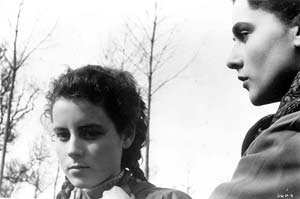 |
 |
 |

 |
|
Date: Fridays and Saturdays, December 8–16, 2006
Time: Fridays at 7:30 p.m., Saturdays at 4:00 and 7:30 p.m.
Location: Getty Center, Harold M. Williams Auditorium
Admission: Free; reservations required. Call (310) 440-7300 or use the "Make Reservations" buttons below.
This series features six films by five directors whose work was inspired by German Romantic painter Caspar David Friedrich. Like Friedrich, these directors—Werner Herzog, Fritz Lang, F.W. Murnau, Carl Theodor Dreyer, and Robert Bresson—depicted what they saw with their "spiritual eye," finding beauty, goodness, and the transcendent in what others might see as ugly and dark.
The series is presented in partnership with the UCLA Film and Television Archive and complements the current exhibition Caspar David Friedrich to Gerhard Richter: German Paintings from Dresden.
|
 |

|

 |
 |
 |
|
(1974, Werner Herzog, 110 min., color, German with English subtitles)
Friday, December 8, 7:30 p.m.

The series begins with Werner Herzog's episodic and meditative film chronicling the mysterious real-life story of Kaspar Hauser, a young man apparently raised from birth in total solitary confinement who was suddenly released by his warden back into the civilized world.
Herzog revises the seminal foundling myth as both a withering social critique and an arch-Romantic probing of eternal questions about truth, knowledge, and human identity.
|
 |


|

 |
 |
 |
 |
|
(1921, Fritz Lang, 95 min., b&w, silent with English subtitles and live
accompaniment by pianist Michael Mortilla)
Saturday, December 9, 4:00 p.m.

Lil Dagover defies Death and tries
in vain to save her lover, Walter Janssen, from his mortal fate. After the framing sequence, which takes place in a timeless rural village, the film plays out variants on this same essential scenario across three exotic settings: ancient Persia, Renaissance Venice, and imperial China.
Lang and his co-writer (and wife), Thea von
Harbou, liberally mined German mythology and
Romantic literature—especially the fantastical works of the Brothers Grimm and E.T.A. Hoffmann—in fashioning a narrative redolent of 19th-century folk tales.
Surrealist Luis Buñuel claimed that, "when I saw Destiny, I suddenly knew that I wanted to make movies."
|
 |


|

 |
 |
 |
 |
|
(1922, F.W. Murnau, 84 min., b&w, silent with English subtitles and live accompaniment by pianist Michael Mortilla)
Saturday, December 9, 7:30 p.m.

An unauthorized film adaptation of Bram Stoker's Dracula, Nosferatu tells the story of a newlywed burgher who sets out to earn a real estate commission from the mysterious Count Orlok. After sampling his visitor's blood, the vampire count journeys aboard a phantom ship to the young man's provincial hometown, bringing the plague—and a thirst for the burgher's beautiful wife—along with him.
Nosferatu was wunderkind director F.W. Murnau's first major success and is commonly considered a high point of German Expressionist film. But Murnau, an art historian by training, was also known as the great Romantic of the Weimar cinema, and the influence of Caspar David Friedrich is pervasive in his deeply evocative use of landscape.
|
 |


|

 |
 |
 |
 |
|
(1928, Carl Theodor Dreyer, 82 min., b&w, silent with English subtitles and live accompaniment by pianist Michael Mortilla)
Friday, December 15, 7:30 p.m.

Many critics believe that this "emotional documentary" is the greatest silent film ever made. Dreyer portrays the last moments of the life of Joan of Arc, as she is convicted of heresy by French clerics and burned at the stake.
Italian actress Renée Maria Falconetti is transcendent as Joan, and most of the film is devoted to close-ups of her face. Just as the Romantics allowed a
natural object to stand for the divine, here it is Falconetti's soulful face that is emblematic of greater truth. The struggle between the material and the spiritual, between institutionalized religion and pure faith, is a common thread between Dreyer and German Romanticism.
|
 |


|

 |
 |
 |
 |
|
(1951, Robert Bresson, 120 min., b&w, French with English subtitles)
Saturday, December 16, 4:00 p.m.

A young Catholic priest is sent to a parish in a small village full of petty, hostile townspeople. On a mission to find grace, the sickly priest examines his role and questions his own motives and ideology as he writes and reads aloud from his daily journal.
Like other films in this series, Diary of a Country Priest is infused with a sense of the shallowness of everyday life and of the constraints of organized religion in the realm of the divine. Bresson was optimistic that there was an "essential soul," and that this soul could be captured on camera.
|
 |


|

 |
 |
 |
 |
|
(1976, Werner Herzog, 74 min., color, German with English subtitles )
Saturday, December 16, 7:30 p.m.

Stylized, mystifying, bizarre, and beautiful, Heart of Glass is one of the most challenging and rewarding films by Werner Herzog. When the owner of a small town's factory dies, the formula of the precious commodity—ruby glass—vanishes. The factory collapses, and with it the town.
Under a trance, the actors uttered lines they had learnt under hypnosis. The trance, and the artist who leads the viewer into it, is a Romantic idea. The natural, eerie settings, and the remarkable climax of the film are also rooted in the Romantics' art.
Please note, due to condition issues with the 35mm print from Germany, Heart of Glass will be presented on 16mm. We apologize for any inconvenience.
|
 |


|

 |
 |
 |
 |
Images from Destiny, Nosferatu, a Symphony of Horror, and The Passion of Joan of Arc courtesy of the Academy of Motion Picture Arts and Sciences.
Text adapted from program notes by Andrea Alsberg and Jesse Zigelstein of the UCLA Film and Television Archive
|
 |
 |







